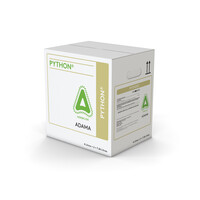
Pest Profile: Stinkweed

This weed is hearty: plants are able to withstand hard spring frosts and midseason droughts, while its seeds have heavy coats that allow them to stay viable in soil for up to seven years. In addition to competing with crops for valuable resources, stinkweed also serves as a host to other pests, like clubroot and tarnished plant bug. Because stinkweed can produce up to 15,000 seeds in a season, it’s imperative to get control of the weed early on in its life cycle.
TYPE
- Winter annual
- Broadleaf
IDENTIFICATION
Stinkweed is known for its unpleasant odour, which has been described as a sour, turnip-garlic-like scent. Plants are between 5-60 centimetres in height, with smooth, erect stems that are often branched. The lower leaves can form a rosette, while the upper leaves clasp the stem. Leaves are alternate and without hairs, and flowers are small and stalked, with white petals and yellow to green centres. Seeds are held in tan-coloured packets.
CONTROL TIPS
- Because winter annuals can be difficult to kill come springtime, and stinkweed can germinate from seed mid-season, after most crops have passed herbicide windows, it’s best to control stinkweed as part of your post-harvest burn-off.
- Control with a combination of tillage and chemical methods is most effective.
- Herbicides containing MCPA or Bromoxynil and 2,4-D are especially effective at controlling stinkweed, when used with the appropriate crops. Most Group 2 chemistries are effective but be aware that the weed has developed resistance to Group 2 herbicides in parts of Alberta (but as of yet has not been found in Eastern Canada).
REGISTERED HERBICIDES
- 2,4-D Ester 700
- BADGE®
- BROMOTRIL®
- DAVAI®80 SL
- DAVAI®A PLUS
- DAVAI®Q PLUS
- EMPHASIS®MAX
- ESTEEM ALL IN®
- FORCEFIGHTER ALL IN®
- ADAMA GLUFOSINATE 150 SL
- INVOLVE® 50 WDG + Glyphosate
- MCPA ESTER 600
- PHANTOM® 240 SL
- PYTHON®
- RUSH 24 ALL IN
- SQUADRON®
Please read each label to determine which herbicide is appropriate for the crop affected.
REFERENCES AND ADDITIONAL READING
Raine, Michael. “Weed of the Week: Stinkweed.” Western Producer. 14 May 2015. Online. https://bit.ly/2o9M6Os
“Stinkweed.” Province of Manitoba Agriculture. Online. https://bit.ly/2o5Rz8R
Related Products

BROMOTRIL® 240 EC
Tough broadleaf weed control with tank-mix flexibility and excellent crop safety.

DAVAI® 80 SL
Broadleaf and grassy weed control in a convenient package that allows for flexible tank-mix options in soybeans, dry beans and field peas.

INVOLVE® 50 WDG
Pre-plant or post-harvest Group 2 herbicide for control of the toughest broadleaf weeds.

PYTHON®
This co-pack alternative provides broad-spectrum weed control in field peas and soybeans with two modes of action to help combat weed resistance.